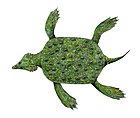
Mamenchisaurus is a genus of sauropod dinosaur known for their remarkably long necks which made up nearly half the total body length. Numerous species have been assigned to the genus; however, many of these might be questionable. Fossils have been found in the Sichuan Basin and Yunnan Province in China. Several species are from the Upper Shaximiao Formation whose geologic age is uncertain. However, evidence suggests that this be no earlier than the Oxfordian stage of the Late Jurassic. M. sinocanadorum dates to the Oxfordian stage and M. anyuensis to the Aptian stage of the Early Cretaceous around 114.4 mya. Most species were medium to large size sauropods, around 15 to 26 meters in length and possibly up to 35 meters (115 ft) based on two undescribed vertebrae.
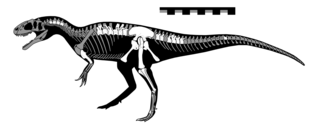
Gasosaurus is a genus of tetanuran theropod that lived approximately 171.6 to 161.2 million years ago during the middle of the Jurassic Period. The name "Gasosaurus" is derived from the English "gasoline" and the Greek σαῦρος. Only one species is currently recognised, G. constructus, from which the specific name honours the gasoline company that found the Dashanpu fossil quarry in Sichuan Province, China, now named as the Lower Shaximiao Formation.

Yangchuanosaurus is an extinct genus of metriacanthosaurid theropod dinosaur that lived in China from the Middle Jurassic to Early Cretaceous periods, and was similar in size and appearance to its North American and European relative, Allosaurus. Yangchuanosaurus hails from the Upper Shaximiao Formation and Suining Formation and was the largest predator in a landscape that included the sauropods Mamenchisaurus and Omeisaurus and the stegosaurs Chialingosaurus, Tuojiangosaurus and Chungkingosaurus. This theropod was named after the area in which was discovered, Yongchuan, in China.
Xiaosaurus, is a genus of small herbivorous dinosaur from the middle Jurassic, approximately 169 to 163.5 mya. Xiaosaurus lived in what is now the Sichuan Basin of China.
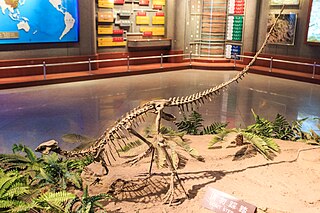
Agilisaurus is a genus of ornithischian dinosaur from the Middle Jurassic Period of what is now eastern Asia. It was about 3.5–4 ft long, 2 ft in height and 40 kg in weight.

Shunosaurus, meaning "Lizard from Sichuan", is a genus of sauropod dinosaur from Late Jurassic (Oxfordian) beds in Sichuan Province in China, from 161 to 157 Million years ago. The name derives from "Shu", an ancient name for the Sichuan province.
Zigongosaurus is a genus of sauropod dinosaur from the Middle Jurassic-Late Jurassic-age Shaximiao Formation of Zigong, Sichuan, China. Because of incomplete knowledge of Jurassic Chinese sauropods, it has been hard to interpret, with some sources assigning it to Omeisaurus, some to Mamenchisaurus, and some to its own genus.
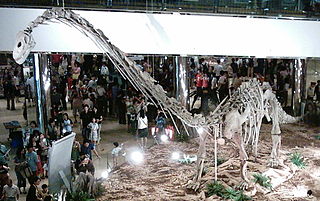
Omeisaurus is a genus of sauropod dinosaur from the Middle Jurassic Period of what is now China. Its name comes from Mount Emei, where it was discovered in the lower Shaximiao Formation of Sichuan Province.
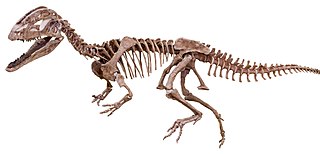
Sinosaurus is an extinct genus of theropod dinosaur which lived during the Early Jurassic Period. It was a bipedal carnivore approximately 5.5 metres (18 ft) in length and 300 kilograms (660 lb) in body mass. Fossils of the animal were found at the Lufeng Formation, in the Yunnan Province of China.

Szechuanosaurus is an extinct genus of carnivorous theropod dinosaur from the Late Jurassic. Fossils referred to the genus have been found in China, Asia in the Oxfordian-?Tithonian. Its type species is based on several undiagnostic teeth from the Kuangyuan Series. Additional possible specimens of Szechuanosaurus were also reported from the Kalaza Formation, also located in China.
Daanosaurus was a genus of dinosaur. It was a sauropod which lived during the Late Jurassic. It lived in what is now China, and was similar to Bellusaurus.
Gongbusaurus is a genus of ornithischian, perhaps ornithopod, dinosaur that lived between about 160 and 157 million years ago, in the Late Jurassic period. A small herbivore, it is very poorly known. Two species have been assigned to it, but as the original name is based on teeth, there is no concrete evidence to connect the two species. Its fossils have been found in China.
The Ziliujing Formation is a geological formation in China, It is Early Jurassic in age. It is part of the stratigraphy of the Sichuan Basin. The dinosaur Gongxianosaurus and indeterminate theropod material are known from the Dongyuemiao Member of the formation, as well as dinosaur footprints, Zizhongosaurus and indeterminate prosauropods from the Da'anzhai Member. The basal sauropod Sanpasaurus is known from the Maanshan Member. An unnamed stegosaur and the pliosauroid plesiosaur Sinopliosaurus are also known from this formation but they were found an indeterminate member. An unnamed teleosaurid known from a complete skull has also been found in the formation, pending a formal description. The deposition environment during the Da'anzhai Member in the lower Toarcian is thought to have been that of a giant freshwater lake encompassing the whole of the Sichuan basin, around 3 times larger than Lake Superior, coeval with the Toarcian Oceanic Anoxic Event around 183 Ma.
Yuzhoupliosaurus is an extinct genus of plesiosaur from the Middle Jurassic of China. The genus is known only from a lower jaw, a vertebra, and fragments of a pectoral girdle. It is believed this genus lived in fresh water.
Paleontology or palaeontology is the study of prehistoric life forms on Earth through the examination of plant and animal fossils. This includes the study of body fossils, tracks (ichnites), burrows, cast-off parts, fossilised feces (coprolites), palynomorphs and chemical residues. Because humans have encountered fossils for millennia, paleontology has a long history both before and after becoming formalized as a science. This article records significant discoveries and events related to paleontology that occurred or were published in the year 1993.
Paleontology or palaeontology is the study of prehistoric life forms on Earth through the examination of plant and animal fossils. This includes the study of body fossils, tracks (ichnites), burrows, cast-off parts, fossilised feces (coprolites), palynomorphs and chemical residues. Because humans have encountered fossils for millennia, paleontology has a long history both before and after becoming formalized as a science. This article records significant discoveries and events related to paleontology that occurred or were published in the year 1984.
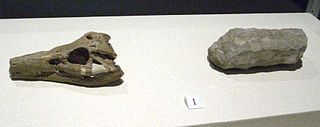
Hsisosuchus is an extinct genus of crocodyliform from China. Currently there are three species within this genus: H. dashanpuensis is from the Middle Jurassic, while H. chungkingensis and H. chowi are from the Late Jurassic. It is likely to have been a medium-sized predator.
The Nanxiong Formation is a Late Cretaceous geologic formation in Guangdong Province. Dinosaur remains are among the fossils that have been recovered from the formation.
Ordosiodon is an extinct genus of therocephalian therapsids from the Early Triassic of China. It includes two species, O. lincheyuensis and O. youngi.











